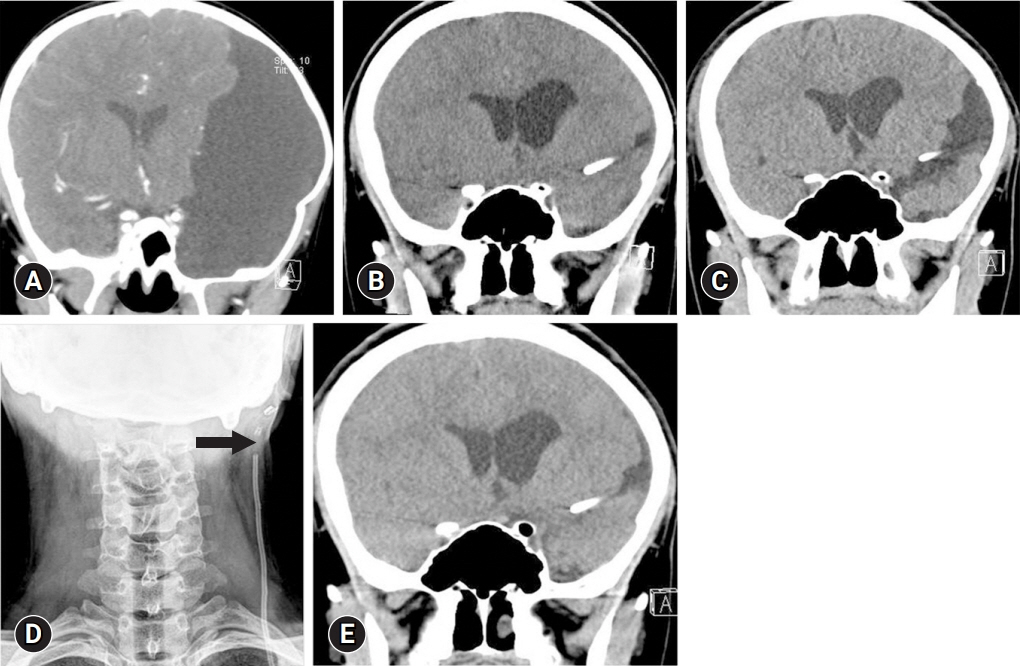J Yeungnam Med Sci.
2023 Nov;40(Suppl):S109-S112. 10.12701/jyms.2023.00479.
Shunt fracture as a sequela of cervical spine manipulation: a case report
- Affiliations
-
- 1Department of Neurosurgery, Keimyung University Dongsan Hospital, Keimyung University School of Medicine, Daegu, Korea
- KMID: 2548351
- DOI: http://doi.org/10.12701/jyms.2023.00479
Abstract
- Shunt disconnection is an unreported complication of spinal mobilization and manipulation. We present the case of a young adult who underwent cystoperitoneal (CP) shunt placement for an arachnoid cyst at the age of 6 years. The shunt remained functional during a follow-up period of 11 years. The patient was admitted with headache and diplopia that started after cervical manipulation by a chiropractor. Radiography revealed fracture of the distal catheter and resultant enlargement of the temporosylvian cyst. The patient required replacement of the disconnected tubing caudal to the shunt valve. The distal catheter ruptured immediately below the outlet connector of the valve. The symptoms and signs resolved completely after insertion of a new distal tube into the peritoneum. This case report demonstrates that chiropractic manipulation of the neck may be a cause of tubing breakage in patients with CP shunts.
Figure
Reference
-
References
1. Ernst E. Chiropractic: a critical evaluation. J Pain Symptom Manage. 2008; 35:544–62.
Article2. Arai H, Sato K, Wachi A, Okuda O, Takeda N. Arachnoid cysts of the middle cranial fossa: experience with 77 patients who were treated with cystoperitoneal shunting. Neurosurgery. 1996; 39:1108–13.
Article3. Erol FS, Ozturk S, Akgun B, Kaplan M. Ventriculoperitoneal shunt malfunction caused by fractures and disconnections over 10 years of follow-up. Childs Nerv Syst. 2017; 33:475–81.
Article4. Lee L, Low S, Low D, Ng LP, Nolan C, Seow WT. Late pediatric ventriculoperitoneal shunt failures: a Singapore tertiary institution’s experience. Neurosurg Focus. 2016; 41:E7.
Article5. Kural C, Kirik A, Pusat S, Senturk T, Izci Y. Late calcification and rupture: a rare complication of ventriculoperitoneal shunting. Turk Neurosurg. 2012; 22:779–82.
Article6. Yamamoto S, Ohno K, Aoyagi M, Ichinose S, Hirakawa K. Calcific deposits on degraded shunt catheters: long-term follow-up of V-P shunts and late complications in three cases. Childs Nerv Syst. 2002; 18:19–25.
Article7. Kim SK, Cho BK, Chung YN, Kim HS, Wang KC. Shunt dependency in shunted arachnoid cyst: a reason to avoid shunting. Pediatr Neurosurg. 2002; 37:178–85.
Article8. Clyde BL, Albright AL. Evidence for a patent fibrous tract in fractured, outgrown, or disconnected ventriculoperitoneal shunts. Pediatr Neurosurg. 1995; 23:20–5.
Article9. Gong W, Wang XD, Liu YT, Sun Z, Deng YG, Wu SM, et al. Intracranial drainage versus extracranial shunt in the treatment of intracranial arachnoid cysts: a meta-analysis. Childs Nerv Syst. 2022; 38:1955–63.
Article10. Puentedura EJ, March J, Anders J, Perez A, Landers MR, Wallmann HW, et al. Safety of cervical spine manipulation: are adverse events preventable and are manipulations being performed appropriately?: a review of 134 case reports. J Man Manip Ther. 2012; 20:66–74.
Article11. Kranenburg HA, Schmitt MA, Puentedura EJ, Luijckx GJ, van der Schans CP. Adverse events associated with the use of cervical spine manipulation or mobilization and patient characteristics: a systematic review. Musculoskelet Sci Pract. 2017; 28:32–8.
Article12. Albuquerque FC, Hu YC, Dashti SR, Abla AA, Clark JC, Alkire B, et al. Craniocervical arterial dissections as sequelae of chiropractic manipulation: patterns of injury and management. J Neurosurg. 2011; 115:1197–205.
Article13. Langmoen IA, Lundar T, Vatne K, Hovind KH. Occurrence and management of fractured peripheral catheters in CSF shunts. Childs Nerv Syst. 1992; 8:222–5.
Article14. Hoover D, Ganju A, Shaffrey CI, Bartkowski H, Rauzzino MJ. Shunt fracture following correction of spinal deformity. Case illustration. J Neurosurg. 2000; 92(1 Suppl):122.
Article15. Blakeney WG, D’Amato C. Ventriculoperitoneal shunt fracture following application of halo-gravity traction: a case report. J Pediatr Orthop. 2015; 35:e52–4.
- Full Text Links
- Actions
-
Cited
- CITED
-
- Close
- Share
- Similar articles
-
- Cervical Spine Fracture Following Non-authorized Manipulation: A case report
- Sagittal Fracture of Cervical Spine: Case Report
- Fracture and Dislocation of the Cervical Spine: Report of 4 Cases
- Cervical Myelopathy after Neck Manipulation
- Anterior Screw Fixation of Anteriorly Displaced Type III Odontoid Fracture Corrected by Transoral Digital Manipulation


